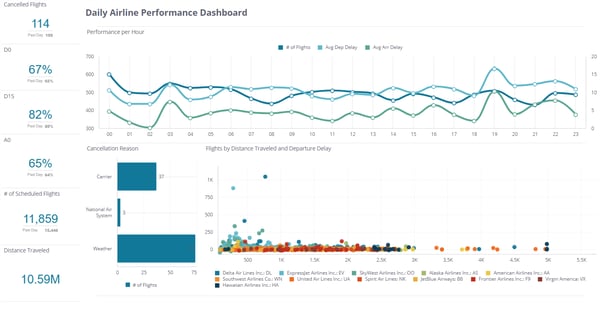
By definition, augmenting involves increasing value or making something greater in size or strength.
With this in mind, augmented analytics adds tons of value to conventional analytics with the power of artificial intelligence. Let’s dive deeper into what augmented analytics is and how to understand it as a whole.
Augmented analytics encourages data democratization by empowering more people in an organization to access data analytics and insights.
Augmented analytics is an automated system that sources and analyzes data using machine learning and natural language processing. With less dependency on data scientists to glean and process data, businesses can unleash the power of data themselves with natural language searches.
With data crunched using augmented analytics, online streaming services like Netflix and Amazon can display tailored content to the user. Financial and government organizations use existing data mined and developed by augmented analytics to identify and mitigate signs of fraud. Various organizations in the public sector are able to better serve people with intelligence powered by augmented analytics.
Having a vision of the future without letting it unfold itself can push your business in the right direction. augmented analytics can be that driving force which leads decision makers to make better-informed judgments using precious data analytics. Of course, there are other techniques that organizations use to stay ahead of time. For example, hard trends can be identified using the power of certainty, power of anticipation, ability to reinvent and redefine.
Augmented analytics can help a business in providing better business intelligence. Simply put, BI can help any business make improved decisions by using data that has been gathered and processed, which leads to more revenue. Starting right from the top of the sales funnel until the bottom end, and then re-engaging/retaining the purchasers, BI plays a key role in every stage of the marketing and sales lifecycle. A good BI tool will collect data from internal and external sources of the business to provide the past, present and future insights.
Why are BI tools that use automated analytics better than traditional BI tools? It’s simple; AI techniques like ML and NLP make the difference.
Previously, BI tools used code or rule-based programs to analyze and process data and then make sense of it. Although it worked, it was not enough to provide organizations with cutting-edge insights that really made a difference. Machine learning programs, on the other hand, are more intelligent. They don’t just go by the rules; they adapt to changes.
A machine learning program can identify patterns and further process data based on those patterns. This means that it can improvise based on its past experiences, much like human intelligence. Forty-eight percent of enterprises who adopted ML saw an increase in profitability as its top benefits.
Another AI technique that brings in the difference is the natural language processing or generation. Humans cannot possibly read machine language, let alone analyzing and gaining insights from them. That’s where natural language generation (NLG) comes into picture.
NLG converts ML into a more human-readable format. ML does all the backend work by generating insights, and NLG processes it in a way that users can understand. For example, if an ML tool finds that there was an increase in sales in December 2019, NLG can go ahead and tell the user that their sales have increased by 20% since that time.
This format makes it very easy for non-technical users to identify insights. It can also take in human-readable search queries and convert the results into visuals. Users can search for queries in a manner that is akin to talking to another human.
Government organizations and businesses are leveraging data analytics in their day-to-day activities to enhance efficiency. Ultimately, every business wants to sell better. Be it their products or services – the only factor driving their success is the revenue generated. Competition has hit so hard in every business sector that getting above it is not an option anymore.
Any BI system is fueled with data analytics which is further transformed into actionable insights. Data that is gathered from various sources and processed in an understandable format. Gone are the days when analytics were code-based and would take months together to come up with key insights using the limited data sourcing capabilities.
With augmented analytics and BI, the reports are more granular, and the predictions smarter. The CIO notes:
“The combinations (BI and augmented analytics) included in these software platforms will make each function more powerful individually and more valuable to the businesspeople using them.”
With effective ways of digging data and offering insights, augmented analytics give stronger power in the hands of decision makers. BI systems that are fueled with augmented analytics are capable of discovering trending insights.
For example, smart data discovery tools today have proven to double the business value by intelligently preparing, analyzing key insights automatically. They are easy to use and self-serviceable, allowing different departments to make more informed decisions.
Augmented analytics helps businesses recognize trends and patterns that lets them plan and prepare better for a stronger future. Machine learning can identify business trends using statistical models on data. Transforming this data into a more human-readable form is performed by the NLG.
These useful insights then act as a strong base to forecast future courses of actions for any enterprise like anticipating a change in product demand, new potential customer locations, seasonal demands and more. For businesses like travel, tourism and hospitality, identifying and predicting customers' buying patterns are invaluable as it allows them to forecast their next steps on marketing and sales.
Below is an example of a daily performance airline KPI dashboard that monitors performance of each airline by tracking each performance KPI. These intelligent tracking capabilities help them enhance their customer experience.

Crunching data using AI is not just more efficient, it is faster. Traditional BI systems took months to clean, analyze data and provide insights owing to the combing of records manually. augmented analytics automates the steps to processing data and can streamline BI within days. Quicker insights mean more power in the hands of decision-makers which will accelerate the process of decision-making.
Often businesses rely on citizen data scientists or IT support to crunch data, analyze and provide insights. With augmented analytics using automated data analysis and processing AI tools, these data analysts can use their precious time in something more productive. It also allows lesser skilled users to gain insights themselves without any external dependencies.
Augmented analytics offers standalone analytics widgets that can allow users to grab insights from their dashboards and add them in a workflow or anywhere else. Also, various sales and marketing actions can be embedded alongside insights.
For example, Kodak combines Yellowfin‘s embedded analytics into their printing workflow software, Prinergy. With the Prinergy application, their customers can forecast resource needs and availability by keeping a track of the ink usage, number of print passes, production volumes, and trends.
The sooner the data is shared with the team, the more productive each one gets. augmented analytics does not just offer data to be analyzed and processed, it can be also shared. augmented analytics platforms provide its users with a social network feature in their dashboard.
When insights are discovered, they can be shared within various branches or decision-makers of an organization via the social network platform. This sharing of data creates a better, more transparent and a faster way of taking significant decisions.
Augmented analytics is not just valuable for businesses. It allows for data democratization, which means that analytics and insights are now accessible through various departments of an organization. This impacts decision-makers, non-decision makers, users, and end-users.

Augmented analytics can be a part of a software or application that Customers use without being known. As mentioned above, we’ve seen how Kodak embeds analytics with their software that is used by their customers to monitor resource availability, their ink usage, number of prints and more. This helps customers to efficiently manage their ink usage.
With the advanced intelligence in augmented analytics, stakeholders and partners of enterprises can make more informed decisions on procurements, strategic activities, quality control, customer acquisitions, retentions and much more.
The AI in augmented analytics will reveal more insights than what is asked for, thus adding tremendous value to businesses and their stakeholders. Smart data discovery allows business stakeholders and partners to discover and visualize insights in the form of predictions, links, correlations, hidden patterns, etc.
Data scientists are rare to find. A study by McKinsey shows that there will be a huge shortage of data scientists – of about 250,000 in the U.S alone by the year 2024. Nonetheless, the entry of augmented analytics has taken the load off from data scientists.
Previously, they were solely depended upon for building prediction algorithms, running repetitive reports and queries. Now, they can focus their time and efforts on more productive issues. They can leverage advanced artificial intelligence and machine learning to solve more complex problems.
Marketers are usually non-technical users. augmented analytics can drastically transform their operations on a daily basis. To make sure that marketers stay within budget, they need to choose more effective outreach programs. Programs that have worked for them previously and / or that have worked in general (data syndication or product review syndication).
With augmented analytics, marketers can make enhanced decisions on what campaigns to pick. They won’t have to depend on their analytics team anymore as the power is now in their hands. To make it easier, marketers can leverage conversational analytics like AI-powered chatbots to access insights just by asking for it.
To be able to ensure that their products and services resonate with their customers, Brand managers are required to stay abreast with market trends and their competitors. augmented analytics tools allow them to easily find deep insights, dependencies and correlations. Thus, empowering brand managers to make smarter marketing decisions.
Seventy-three percent of consumers prefer personalized advertising. Augmented analytics tools can immensely help brand managers in personalizing ad and marketing campaigns.
Time is extremely crucial for salespeople. A delay in acting upon existing analytics can cost them a customer. augmented analytics has proven to speed up and enhance results throughout the various stages of the marketing and sales pipeline. Like marketers, salespeople also do not have to wait or depend upon data analysts to transform data into insights.
They can check on their wins, losses, performance metrics, location-based sales, and more with natural language searches in the analytics dashboard provided by augmented analytics tools. The sales head can use the dashboard to keep a tab on the performance of each sales representative.
Data moves the world, and organizations are spending tons of their budget to harness the data collected. BI systems offer to process and analyze corporate data to aid in decision-making. Unfortunately, not many uncover insights that can make a difference to your business. When BI is driven by augmented analytics, it creates a more intelligent and powerful automated analytics system.
Leveraging the competencies of AI techniques like ML and natural language processing, augmented analytics offers a whole new level of business intelligence. It is termed as a disrupter that can transform how analytics content is developed. Enterprises adopting augmented analytics into their BI platforms at an early stage can see unprecedented insights speed and a competitive edge.
Get more insight into all things analytics by using the right platform for your company's needs – only on G2.
Shefali Shetty is the Marketing and Communications manager at Specbee, a Drupal development company. She enjoys sharing knowledge and articles around technology innovations and open source.
Data is the lifeblood of business success. However, simply having access to massive amounts of...
 by Devin Pickell
by Devin Pickell
When it comes to buzzwords used by businesses, analytics has got to be at the top of the...
 by Mara Calvello
by Mara Calvello
Business intelligence (BI) is making a significant impact across industries by helping...
 by Sagar Joshi
by Sagar Joshi
Data is the lifeblood of business success. However, simply having access to massive amounts of...
 by Devin Pickell
by Devin Pickell
When it comes to buzzwords used by businesses, analytics has got to be at the top of the...
 by Mara Calvello
by Mara Calvello


